soziale stadt - bundestransferstelle
besonderem Entwicklungsbedarf - Soziale Stadt"
Singen Langenrain
|
Stefan Geiss |
|
In Baden-Württemberg, implementation of the "Socially Integrative City" programme is subject to greater restrictions than in other states owing to the framework conditions laid down by the state government. The Federal/Länder programme is interpreted as making funds available "basically only for investment in urban development measures in spatially delimited areas." (1) This condition makes cross-authority resource bundling and the coordination of various actors a difficult management task.
1. Nature of the Area 
The model area Singen-Langenrain is a purely residential area. The approximately 350 dwelling units were built between 1960 and 1976, with the exception of two publicly-assisted housing multi-family units (and a children's house), which were completed in 1991. The municipal housing company (GW Singen mbH) and a housing cooperative (Baugenossenschaft Hegau eG) share most of the housing stock between them. Twelve company dwellings have now passed into the ownership of the tenants (mostly Turkish residents).
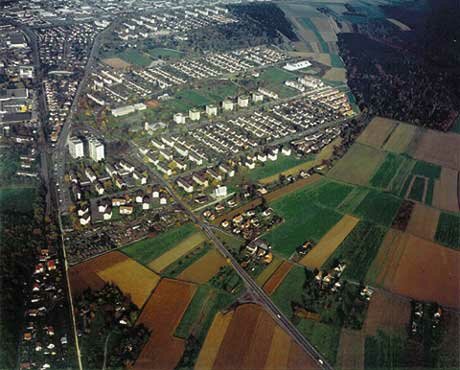 |
| South Singen (Source: Singen Municipality) |
The 30 buildings in the model area are all four-storey point blocks and terrace buildings. Originally, the construction of free-standing single-family, semi-detached, and row units had been planned. In the late 1950s these plans were abandoned. Basic design multi-family units were built instead to accommodate refugees and the (formerly nomadic) Yenish community, who had previously been housed in barracks in the immediate vicinity. In late 1999, when the Langenrain estate was included in the programme "Districts with Special Development Needs - Socially Integrative City," two buildings were let out to the county to accommodate asylum seekers, civil war refugees, and ethnic German immigrants from eastern Europe.
 |
Boundaries of the model area (Source: Singen Municipality) |
Langenrain is in the Südstadt district of Singen, two kilometres away from the centre of town, and constitutes the boundary of settlement in the municipality, beyond which are open fields. Immediately adjacent to the model area itself is housing built largely in the 1960s and 1970s (extended in the 1980s and 1990s by single-family units) following the development of a major industrial area (800 metre wide commercial/industrial zone between Singen-Südstadt and the centre of town).
The resident structure in the neighbouring single-family, semi-detached, and row houses, and modernised rental flats (often privately owned by residents) is socially stable. In the model area proper, by contrast, socially deprived households have always lived, owing to the historical background (very simple housing owned by the municipal housing company and low rents). Traditionally, the image of the area is correspondingly negative. There are a number of major differences between Langenrain and the rest of Singen, as demographic and socio-spatial data show.
2. Main Problems and Development Potential 
The Singen housing market has eased in recent years because the population stagnated for the first time in the 1990s (in contrast to rapid growth after the Second World War, when it doubled between 1945 and 1990). In the late 1990s, there was even a decline in population figures. At present, they are rising again slightly. The eased situation on the housing market has allowed socially stable households, who now have the choice, to move out of Langenrain. Owing to the basic mode of construction (largely without heating, bad insulation, a large number of very small flats, etc.) many of the households that have moved in are "problematic." With the exception of the two new social-welfare housing multi-family blocks and a few flats belonging to the cooperative, the dwellings are no longer subject to occupancy restrictions and allocation by the municipality.
Among the main problems confronting Langenrain is that relations between neighbours have deteriorated with the departure of old-established residents (including many families). The arrival of new, "problematic" households has led to the decay of the "protective" milieu that had developed over years of living together. An atmosphere of tension and aggression has developed. Children and adolescents live in a neighbourhood with weak economic and societal relationship networks. Sometimes criminal "careers" result. In 1999, 30% of young people and adolescents in Langenrain had a criminal record (as opposed to 10% in Singen as a whole).
The open design of the spaces adjoining dwellings (asphalt parking areas right up to the buildings without protective buffer zones) gives residents a feeling of insecurity and diminishes their sense of responsibility. At the start of the "Socially Integrative City" programme, the dwelling environs were accordingly in a very neglected state. Buffer strips and streets (visible from all sides) were encumbered with old furniture, other bulky refuse, and overflowing dustbins (except in the immediate vicinity of the housing cooperative). This badly damaged the external image of the area. Stigmatisation meant that young people applying for training positions or unemployed adults looking for work were often rejected simply on the grounds of their address.
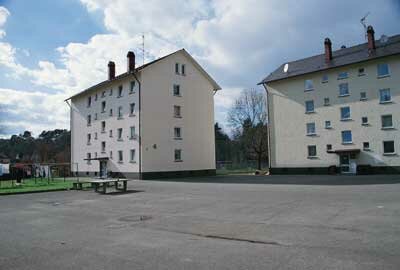 |
Building set-backs without protective buffer zone (Source: empirica, Berlin) |
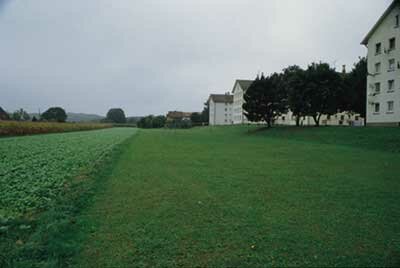 |
Attractive location bordering on open fields (Source: empirica, Berlin) |
In spite of the criticism expressed by Langenrain residents and people from neighbouring residential areas at the starter conference and in many individual discussions, the area as such is favourably assessed. Furthermore, the attractive location of the area is a major asset. The wide view across the open landscape, the recreational quality offered by the proximity of meadows, fields, and woods, and a socially stable population structure close by are also reasons for the basically favourable assessment.
3. Development Goals and Focal Points of Action 
Given the locational qualities of the area, which are recognised by residents of South Singen over and beyond the model area, the "steering group"(cf. 5 Organisation and Management) decided to adopt a thoroughgoing improvement strategy. The development goal is to counteract stigmatisation and, in the medium and long term, to reverse the trend towards ghettoization. The focal points of action under the strategy are the achievement of a stronger social "mix" in the resident population, the modernisation and privatisation (flat ownership for tenants) of housing, and the demolition of certain sections to provide additional inexpensive housing for sale. Modernisation and new housing are hoped to retain or win socially stable households for the area.
Demography and Social Space (2000)
|
Langenrain |
Singen |
|
|
Size |
5.2 ha |
6 177 ha |
|
Population |
(1) |
43 932 |
|
Population decline |
(2) |
(3) |
|
Average household size |
1.9 pers. |
2.3 pers. |
|
Number of dwellings |
350 (4) |
n.a. |
|
Vacant dwelling units |
(5) |
n.a. |
|
Housing benefit recipients |
n.a. |
3.1 % |
|
Unemployment rate |
n.a. |
11.9 % |
|
Social assistance recipients |
17 % |
5.9 % |
|
Foreign population |
46 % |
17 % |
|
Population under 18 |
29 % |
19 % |
|
Population 60 and older |
14 % |
27 % |
|
|
||
Since this improvement requires social stabilisation, action focuses on a second point. On the initiative and with the support of the steering group (cross-authority decisions and support) joint efforts with various actors (schools, Child Protection Association, employment office, local programme support team) are being made to mitigate residents' social and economic problems and to mobilise their competencies.
These development goals and focal points of action are to be understood as framework planning that is to be filled out and updated in the course of events. Even before the model area was included in the "Socially Integrative City" programme, the municipal housing company had commissioned a study to look into the problems of the area and propose solutions (SWOT analysis carried out by empirica in 1999). Three development scenarios were put forward. The one that found favour with the supervisory board of the housing company recommended a "partly new population structure."
Upon inclusion in the "Socially Integrative City" programme, the Singen municipality commissioned the municipal housing company, which is in charge of renewal, with carrying out a preparatory study. This study took up and concretised the findings of the SWOT analysis (determining which buildings were to be modernised or demolished; first proposals for social measures, etc.). In parallel with establishment of the steering group, the elaboration of an urban framework plan with open planning procedure was commissioned from the firm Büro Both by the municipality . The results of the preparatory study were updated in the steering group as an integrated plan of action (in the responsibility of the neighbourhood manager). Implementation of the plan allows for decisions on how many buildings are to be modernised or demolished to be made contingent on actual demand. This prevented capital being misdirected (no funding to modernise dwellings for which there is no demand). Originally, it was planned to demolish only two buildings and to modernise the rest. After modernisation of the first, however, it emerged that, despite the moderate rent of DM 8.50 per square metre, demand was very hesitant. For this reason, two additional buildings are now to be demolished instead of being modernised.
The steering group has agreed that vacated sites should be made available to build inexpensive homes for current residents of Langenrain and neighbouring areas unable to buy without favourable offers. In order to keep the cost of such homes as low as possible, the steering group (in consultation with experts) has elaborated a case for obviating compensation under Article 155 (4) for submission to the town council. The question whether costs can be reduced through "professionally" controlled group payments (substitute for own capital contribution) is also being gone into (investigation of other projects).
4. Key Projects 
The careful modernisation of residential buildings aims to eliminate substandard aspects (energy modernisation, sanitary installations, balconies, and dwelling environs) and to provide family dwellings (merging small flats to make family-sized ones). So far, all residents of the buildings that have been modernised have been visited personally (instead of "surgery management") and interrogated about their needs, wishes, and financial possibilities. During modernisation work, they were offered alternative accommodation with the option of moving back; "rehabilitation refugees" were to be avoided. So far, all tenants in housing company dwellings have been accommodated elsewhere, and most do not want to return.
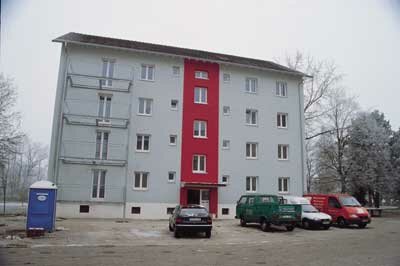 |
Housing modernisation (Source: empirica, Berlin) |
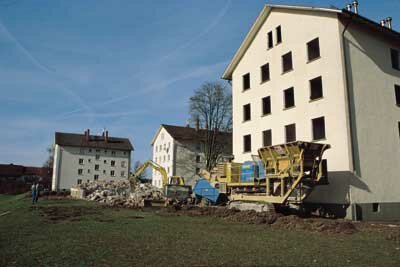 |
"Careful" demolition (Source: empirica, Berlin) |
The aim of the "Workshop for Integration and Placement" is to facilitate access to "normal" facilities (training and labour market) for variously disadvantaged population groups. Members of such groups need to be enabled to deal with the problems they face in life and the everyday world:
- Children and young people still attending school are to be taught the simplest everyday qualifications (punctuality, perseverance) in activities that interest them personally, e.g., repairing bicycles, with the aim of stabilising a perspective on life with gainful employment as an integral part. The target group is young people from families that have been dependent on transfer payments for several generations. Young Yenish, Sinti, and Roma are generally firmly integrated in their social networks and have no contact with the "normal" labour market.
- Young people without training positions, who because of their isolated experience of the world have no incentive to look for such a position, or who have difficulty "staying the course," are to be motivated in the context of a meaningful occupation/ qualification. With guidance (craftsman, social educationalist) and individual support, they are to learn everyday qualifications to help them out of the poverty trap. The focus is on identification with the district (meaningful activities in consultation with the housing companies) and guidance towards insertion in the labour market through targeted personality training (occupational maturity), which includes both the acquisition of social and occupational skills and the "playful" acquisition of education (Internet, data processing, etc.).
- Single mothers unable to cope with organising everyday life (e.g., providing their children with healthy food, managing money) are to be integrated in the medium term in the workshop project. Everyday skills are to be learned not through theoretical training but by practical activity. For example, meals could be prepared for the children from the children's house and possibly for the young people employed in the workshop (link between planning and shopping).
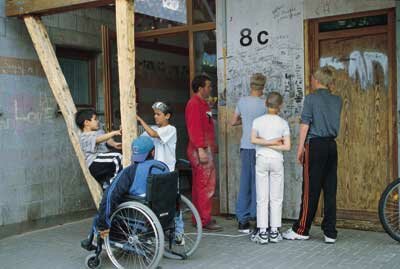 |
Remedial work on the children's house (Source: empirica, Berlin) |
It is planned to support the workshop investment measures through the "Socially Integrative City" programme. Combination with other support programmes is currently being considered in cooperation with the employment office for the knock-on financing of non-investment measures (especially personnel).
Under the direction of an artist, young people with "no place to go" in the residential area have carried out remedial measures in the children's house. In the medium and long term, the house is to be extended: homework help and social behaviour practice are to be offered, and open youth work initiated. The following measures are envisaged:
- On the fringe of the residential area containers are to be set up as "covered hangouts" for "problematic" cliques of young people in the winter months (later: integration in the planned workshop).
- A bicycle repair shop is planned (in combination with the workshop).
- Individual counselling is to be offered for young people as well as joint visits to training and employment institutions to overcome "prejudices" and obstacles.
- Excursions are to be organised with young people (financed by sponsoring).
5. Organisation and Management 
The neighbourhood development planned for Langenrain, which is hoped to bring not only stabilisation but, in the medium and long term, a thoroughgoing upgrading of the residential area, cannot be pursued like any other municipal development project. For this reason, a "steering group" has been set up. Permanent members include the Department of Building; the Department for Youth, Social Affairs, and Public Order; the Department of Finance; firms; the two housing companies; and the neighbourhood manager, who is established in the municipal housing company. The purpose of the steering group is to prepare and coordinate the individual measures (including financing). It draws up proposals for the binding decisions that are to be taken by the local council. The measures prepared and coordinated by the steering group are oriented on local needs.
The tasks of the neighbourhood manager include not only organising citizen meetings and various working parties with residents but also acting as mediator between the residential area and the steering group. He is in constant contact with residents (regularly visiting all households and conducting informal discussions with residents).
 |
Organisation of Programme Implementation |
From time to time, representatives of various institutional actors (e.g., social services, schools) meet at district conferences and draw up proposals (projects, measures) for the steering group (consultative participation by these actors). The process is accompanied by working parties formed by residents and/or experts (e.g., landscape architects) to deal with the specific areas of action.
There are considerable problems with regard to non-investment measures. For example, in the interpretation put on the Federal/Länder programme in Baden-Württemberg, the neighbourhood manager should have contact with residents only in connection with building measures (modernisation and removals). To a large extent, social stabilisation can be achieved only through non-investment measures. Since in Baden-Württemberg such measures cannot be supported under the "Socially Integrative City" programme and no knock-on financing is possible either, there are considerable obstacles that can be overcome only with particular commitment on the part of all actors: through "non-salaried" collaboration; by finding sponsoring organisations concerned not only with financing their staff and infrastructure but who are also committed to an integrated, targeted approach (more work without more financial support). (2)
In the meanwhile, cooperation between the various members of the steering group has given rise to a sense of overall responsibility, and other service providers (especially schools) and actors with appropriate expert knowledge are gradually being included in the group.
6. Activation, Participation, and Public Relations 
In Singen, renewal is understood and practiced as a bottom-up strategy:
Activation and participation in decision-making
The SWOT analysis (informal individual/group discussions and area inspections) and the preparatory study gathered on-the-spot information on the need for action, and identified conflicts, problems, and resources in the residential area through statistical analyses and "outreach enquiries" (personal interviews in dwellings) by the neighbourhood manager and the local programme support team. Local enquiries are regularly up-dated by the programme support team and the neighbourhood manager. In addition to investigating needs from the point of view of the residents, expert knowledge was drawn on. Discussions were held, in particular, with locally operating actors and representatives of the most important institutions that play a role in the neighbourhood.
On the basis of the findings presented by the SWOT analysis, the strategic goals and focal points of action were defined (steering group) and a starter conference organised (integration of residents in the decision-making process). About 200 residents took part in the conference. Project ideas were discussed among residents and all the actors involved, such as the housing companies, the municipal authorities, schools, children's institutions, etc. At this event, young people called attention to the problems as they saw them (preparation through "clique discussions"). The results of the starter conference were analysed in depth, concretized, and feasibility-tested by the inter-authority steering group (legal aspects, financing). Following the conference, three professionally moderated working party meetings were held (open citizen participation on the "urban framework plan" with between 11 and 27 participants); the topics dealt with were "settlement/green and open spaces," "transport/mobility/shopping/work/industry," and "culture/social affairs/infrastructure."
At an issue-specific conference in February 2002, the concretised and feasibility-tested projects were discussed with citizens (personal invitations to all residents of the model area and neighbouring residential areas) and various actors. Young people from the neighbourhood enlivened the conference with a musical performance.
Given the composition of the population in Langenrain, the main problem is not obtaining the participation of residents in individual activities but establishing framework conditions for people to learn to master their lives without external help in the medium and long term instead of relying on the care and support of the welfare state. Two examples in this direction are, first, efforts to introduce low-threshold integration and placement measures, and, second, framework planning for dwelling environment design that focuses less on urban development "qualities" than on social-space criteria (sustainable and conflict-free use of the residential environment). A workshop bringing together green space planners, the planning authority, and the housing companies examined the experience that other municipalities have had in these fields and the extent to which it could be transferred (in particular, lasting acceptance by residents). The next step planned is specific implementation measures with the participation of residents.
Public relations
Events like the starter conference, the issue-specific conference, district conferences, workshops, and installation of residents in the modernised building were accompanied by press releases, and to some extent journalists were personally invited to attend. The public stigmatisation of the past has meanwhile given way to positive cooperation with the media. Between the end of 2000 and the beginning of 2002 some 40 favourable reports appeared on the model area and the "Socially Integrative City" programme. Headlines have already addressed the initiated neighbourhood improvement.
7. |
Conclusion: Radical Improvement only with Far-Reaching Cooperation
|
Owing to the Baden-Württemberg practice of financing only non-investment measures under the "Socially Integrative City" programme, cross-authority work and the achievement of synergies through resource bundling is rendered more difficult. A more additive than integrative approach is the result.
Despite these comparatively unfavourable conditions, cooperation between very heterogeneous actors has so far succeeded. For example, administrative fragmentation has been overcome in the steering group. In order to develop and put into effect an overall strategy, cooperation between municipal authorities has been expanded: cooperation with schools and the employment office.
Not only "hobby projects" of the municipality and measures promoted by highly articulate residents have been launched, as so often. Development goals and focal points of action take account of the SWOT analysis, and measures are not restricted to visible and tangible improvements (e.g., embellishment of the residential environs, clean playgrounds, new play facilities, premises for mothers' centres, etc.). A radical improvement strategy aims in the medium and long term to reverse the trend towards ghettoization and to establish a social mix in the model area. The aim of the "Workshop for Integration and Placement" is to overcome the dependence on transfer payments so widespread in the model area.
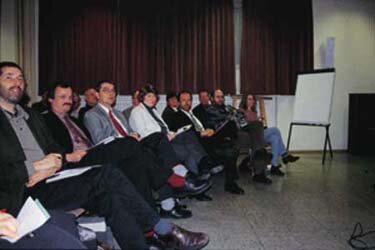 |
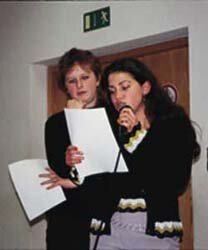 |
| Starter conference (Source: empirica, Berlin) |
|
The resources and concepts of the "Socially Integrative City" programme do not (yet) suffice to ensure a radical improvement in public services. Schools and other institutions (e.g., children's house) in a residential area with an extremely high proportion of foreigners (50% in Langenrain) need greater capacities and must offer more. A school in such a neighbourhood must offer a "different" product or product combination than, for example, a school in an exclusive residential district. Standardised "mass projects" are not sufficient. In an age of immigration and differentiation in the working world, the government must act at a more local level, more clearly in concert with local conditions. The Federal/Länder programme "Socially Integrative City" has opened doors, now the rooms behind them must be filled with content.
References
(1) Bekanntmachung des Wirtschaftsministeriums über die im Jahr 2002 vorgesehenen Programme für die städtebauliche Erneuerung und Entwicklung, Absatz 4: Bund-Länder-Programm »Stadt- und Ortsteile mit besonderem Entwicklungsbedarf – die Soziale Stadt« (21.5.2001, Az.: 6-2521.2-02/1). ![]()
(2) In Singen this lack could be compensated by "chance," for a local project support team set up for the model area was able to assume neighbourhood management (project control and documentation). ![]()
Im Auftrag des BMVBS vertreten durch das BBR. Zuletzt geändert am 07.03.2007